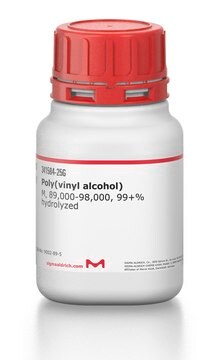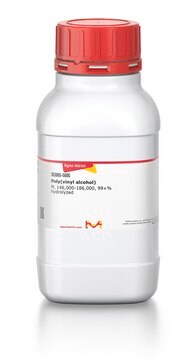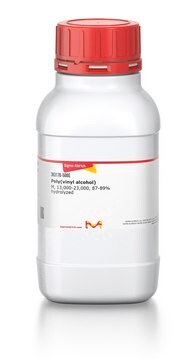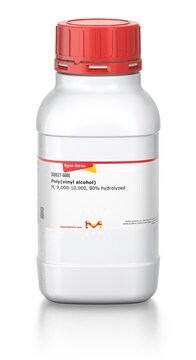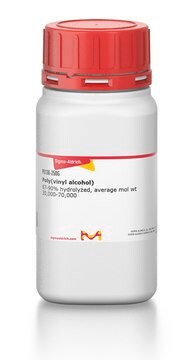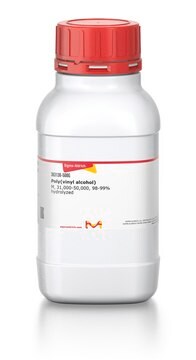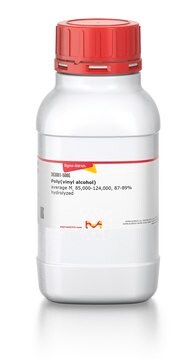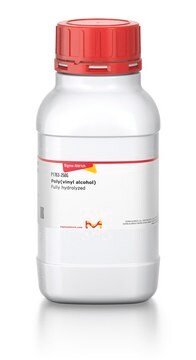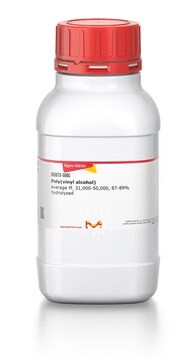363146
Poli(vinil alcohol)
Mw 85,000-124,000, 99+% hydrolyzed
Sinónimos:
PVA
Iniciar sesiónpara Ver la Fijación de precios por contrato y de la organización
About This Item
Fórmula lineal:
[-CH2CHOH-]n
Número de CAS:
Número MDL:
Código UNSPSC:
12352104
NACRES:
NA.23
Productos recomendados
Nivel de calidad
formulario
powder or crystals
mol peso
Mw 85,000-124,000
Bola descendente
28-32 cP, 4 % in H2O(20 °C)(lit.)
InChI
1S/C2H4O/c1-2-3/h2-3H,1H2
Clave InChI
IMROMDMJAWUWLK-UHFFFAOYSA-N
¿Está buscando productos similares? Visita Guía de comparación de productos
Descripción general
Poly (vinyl alcohol) (PVA) is a useful industrial, medical and biomimetic material. PVA with high molecular weight is useful in preparing gel which possesses both high strength and modulus. Hence, it is used for the production of fibers, films or gels.
Aplicación
- Poly (vinyl alcohol) recent contributions to engineering and medicine: This article discusses the diverse applications of PVA in engineering and medical fields, emphasizing its versatility and potential in various domains (Feldman, 2020).
- Chemical modification of poly (vinyl alcohol) in water: This study explores the chemical modification processes of PVA, enhancing its functional properties for advanced material applications (Awada & Daneault, 2015).
- Crosslinked poly (vinyl alcohol) hydrogels for wound dressing applications: Reviews the use of PVA in creating hydrogel dressings for medical applications, demonstrating the material′s effectiveness in healing and treatment scenarios (Kamoun et al., 2015).
- A review on mechanical and water absorption properties of polyvinyl alcohol based composites/films: This review focuses on the mechanical and water absorption properties of PVA composites, crucial for developing advanced materials in various scientific and industrial applications (Jain et al., 2017).
- Properties and applications of polyvinyl alcohol, halloysite nanotubes and their nanocomposites: Analyzes the synthesis, properties, and applications of PVA-based nanocomposites, highlighting their significant potential in nanotechnology and material science (Gaaz et al., 2015).
Código de clase de almacenamiento
11 - Combustible Solids
Clase de riesgo para el agua (WGK)
WGK 1
Punto de inflamabilidad (°F)
No data available
Punto de inflamabilidad (°C)
No data available
Equipo de protección personal
Eyeshields, Gloves, type N95 (US)
Elija entre una de las versiones más recientes:
¿Ya tiene este producto?
Encuentre la documentación para los productos que ha comprado recientemente en la Biblioteca de documentos.
Los clientes también vieron
B D Price et al.
Physics in medicine and biology, 55(4), 1177-1188 (2010-01-29)
We have developed a novel phantom material: a solution of polyvinyl alcohol (PVAL) in ethanol and water, freeze-thawed to produce a solid yet elastically compressible gel. The x-ray attenuation and mechanical properties of these gels are compared with published measurements
Design and development of papain-urea loaded PVA nanofibers for wound debridement
Shoba E, et al.
Royal Society of Chemistry Advances, 4(104), 60209-60215 (2014)
Active chitosan/PVA films with anthocyanins from Brassica oleraceae (Red Cabbage) as Time-Temperature Indicators for application in intelligent food packaging
Pereira VA Jr, et al.
Food Hydrocolloids, 43, 180-188 (2015)
Synthesis and characterization of CdS quantum dots with carboxylic-functionalized poly (vinyl alcohol) for bioconjugation
Mansur HS, et al.
Polymer, 52(4), 1045-1054 (2011)
Adam C Wilkinson et al.
Nature, 571(7763), 117-121 (2019-05-31)
Multipotent self-renewing haematopoietic stem cells (HSCs) regenerate the adult blood system after transplantation1, which is a curative therapy for numerous diseases including immunodeficiencies and leukaemias2. Although substantial effort has been applied to identifying HSC maintenance factors through the characterization of
Nuestro equipo de científicos tiene experiencia en todas las áreas de investigación: Ciencias de la vida, Ciencia de los materiales, Síntesis química, Cromatografía, Analítica y muchas otras.
Póngase en contacto con el Servicio técnico